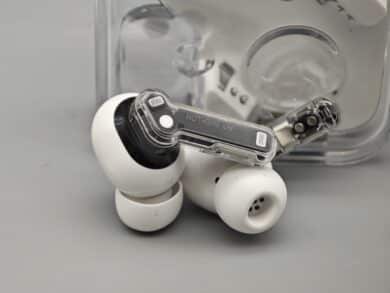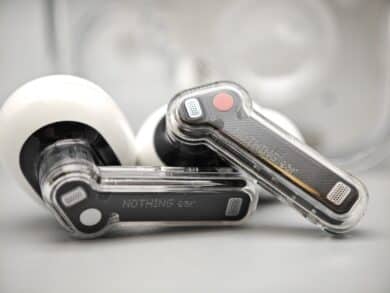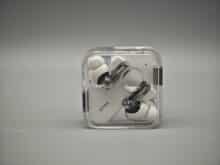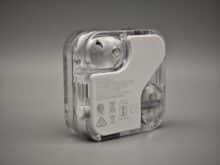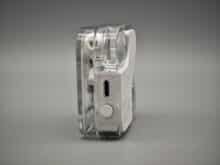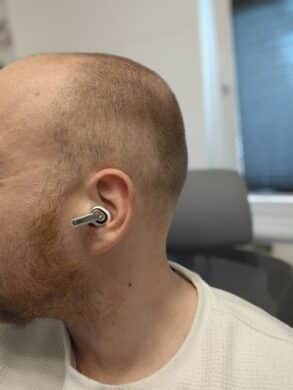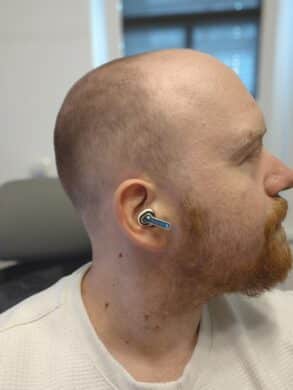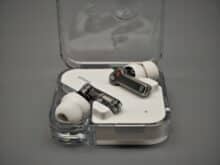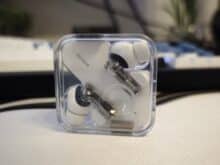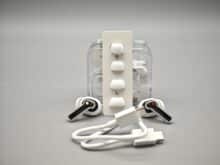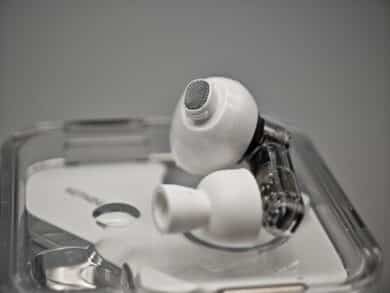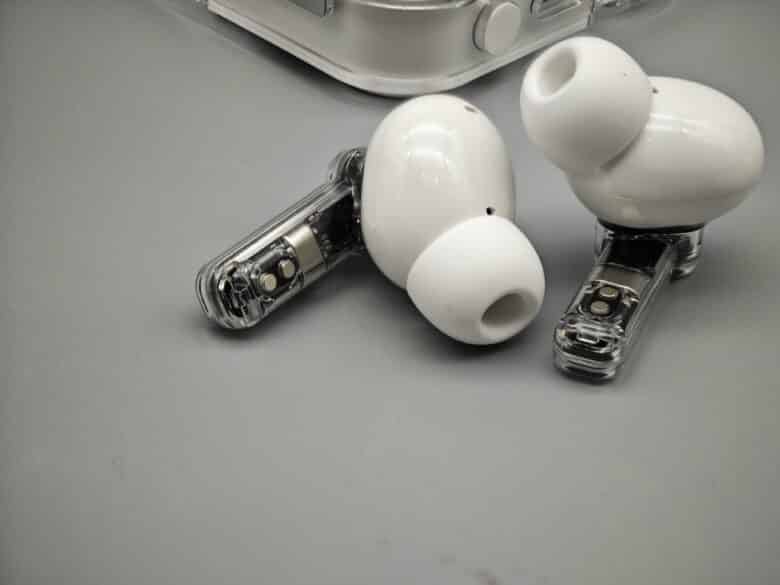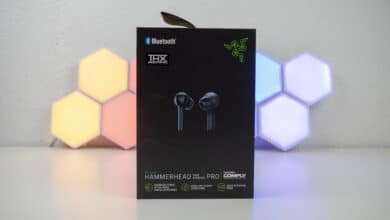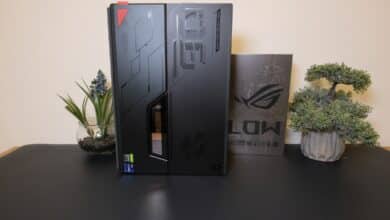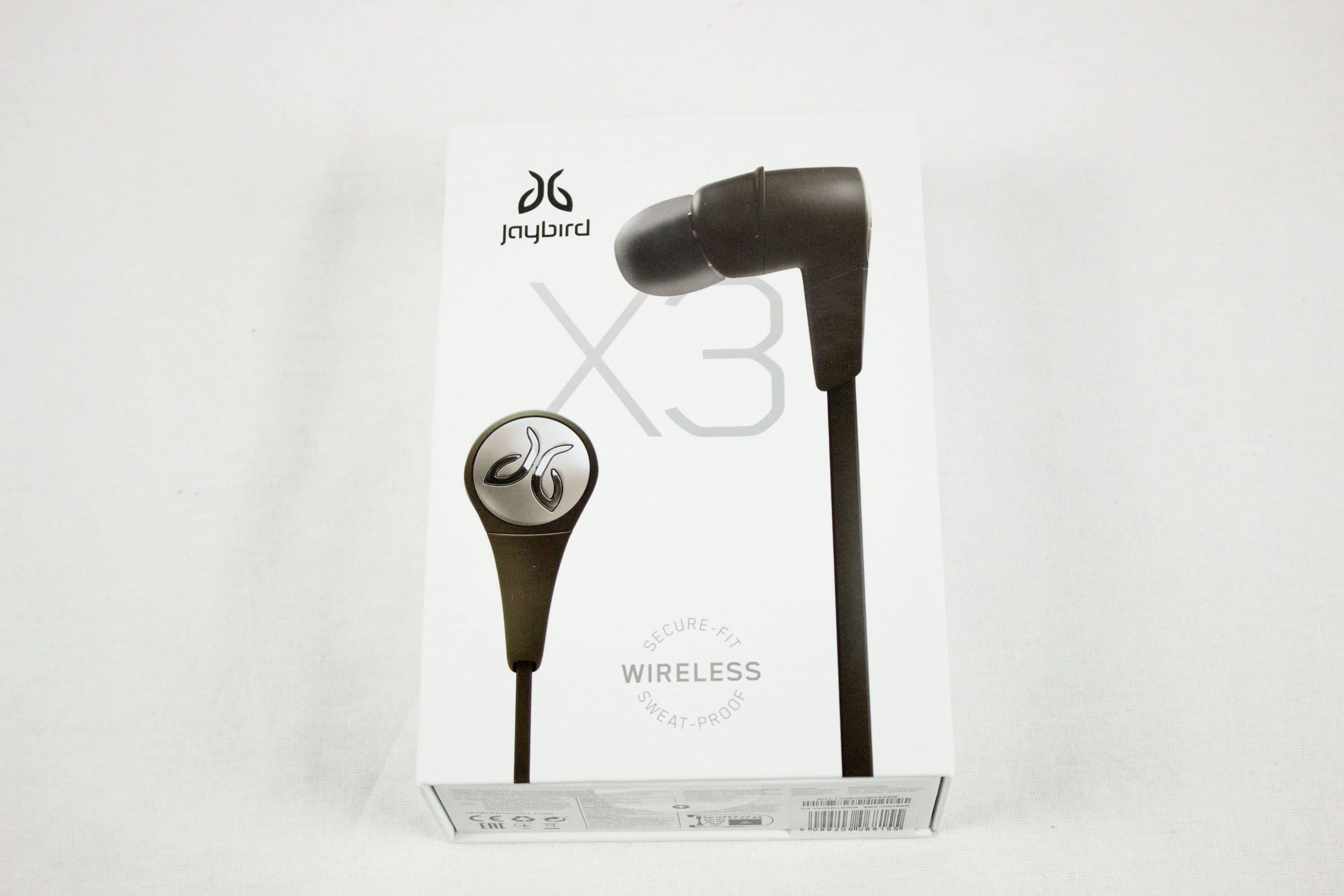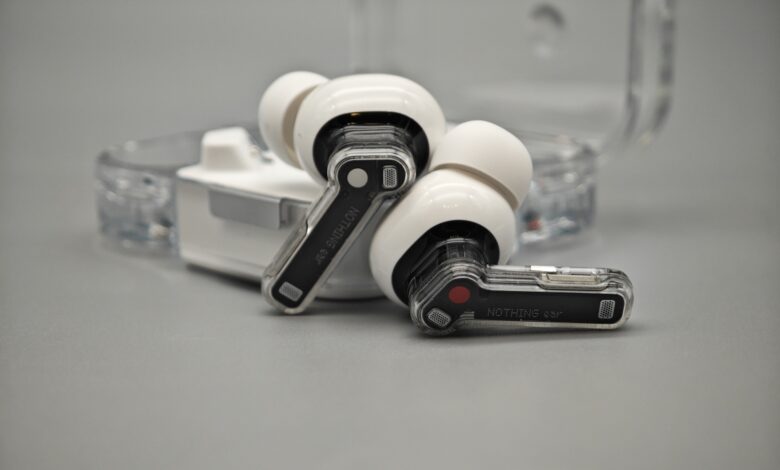
The successor to Nothing Ear (2) has arrived and is called… not Nothing Ear (3). This is because the tech company from the UK has done away with the number in the name. However, this is the only sacrifice that has to be made with the new Nothing Ear, as the in-ear headphones make significant gains in all other areas. Our test reveals why there’s no getting around the Nothing Ear in the range up to 150 euros.
Technical data
| The product | Nothing Ear |
| Bluetooth version | 5.3 |
| Bluetooth codecs | AAC, SBC, LDAC, LHDC 5.0 |
| Maximum operating range | 12m (without obstacle) |
| Battery life |
|
| Charging time | 1.5 hours (for charging case via USB-C or wireless) 10 minutes for 10 hours of playback |
| Size of charging case (H x W x D) | 55.5 mm x 55.5 mm x 22 mm |
| Weight | 4.62 g per earbud; 51.9 g charging case & earphones |
| Most important functions | ANC; transparency mode; wear detection; multipoint, gaming mode, ChatGPT |
| Price | € 135.19 * |
The design remains unique
- unique, transparent design
- convincing workmanship
- pleasantly low weight
The Nothing Ear take up the transparent design of their predecessors, which now enjoys absolute cult status. And rightly so in my opinion, because the earbuds stand out from the crowd.
They also come in a transparent, square case that slides comfortably into your pocket. The earbuds themselves feature the Nothing Ear print on the styles and come with a black or white base. Microphones, controls and magnetic charging pins: Absolutely everything can be seen behind the transparent cover. The black main surface has a pleasant grain.
A red dot indicates the right earbud, a white dot the left. So simple and yet so easy to understand. It is undoubtedly a minimalist design that characterizes the manufacturer’s products and makes them so special. I personally find it very appealing and elegant.
Despite the transparent and fragile look, there is absolutely nothing wrong with the workmanship. The earbuds and case are very robust and have a high-quality feel. Only the lid of the charging case has minimal play to the left and right. On the other hand, the earbuds are IP54 water and dust resistant and the case is IP55.
With a weight of 4.62 grams, the earbuds themselves have become slightly heavier, but are still among the lightest models on the market. The dimensions of 29.4 mm x 21.7 mm x 24.1 mm also promise a high level of wearing comfort.
Excellent wearing comfort
- outstanding wearing comfort
- pleasant shape
- 3 sizes of silicone ear inserts
I recently took a closer look at the Cambridge Audio Melomania M100 for the test. Really excellent sounding earbuds, but they failed miserably in terms of wearing comfort. The Nothing Ear, on the other hand, are among the most comfortable in-ear headphones I’ve ever had the pleasure of wearing.
This is partly due to the low weight, but also to the pleasant round shape of the body, which fits perfectly into the ear and provides a high level of comfort over several hours. This is probably also due to the shiny, somewhat “slippery” design, which is very comfortable compared to the matt, roughened surface of many competitors.
This makes it easy to get over the fact that Nothing only includes two other sizes (M and L) in addition to the pre-installed silicone ear inserts in size M. Both small and large ears are excellently served.
Top features and powerful operation
The Nothing Ear make a considerable leap forward in terms of features, putting even earbuds twice as expensive in their place. They use the modern Bluetooth 5.3 standard and offer a very good range of around 12 meters to the audio source without any dropouts.
The high-resolution audio codecs LDAC and LHDC 5.0 are also offered, which of course require a correspondingly compatible end device as a player, but then significantly improve the sound quality. Unfortunately, Qualcomm’s aptX codecs are not available.
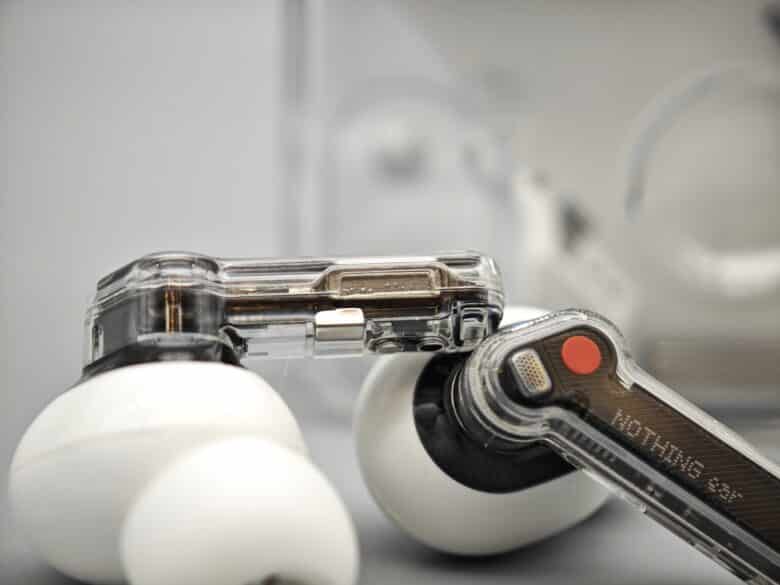
But multipoint, which allows the Ear to be paired with two audio sources simultaneously. Wearer detection and mono mode also work perfectly. If one of the earbuds is removed, playback pauses until it is reinserted or we resume it manually. Alternatively, playback continues when both in-ears are removed and reinserted. Thanks to Google Fast Pair and Microsoft Swift Pair, pairing on Android and Windows devices is also pleasantly fast and convenient.
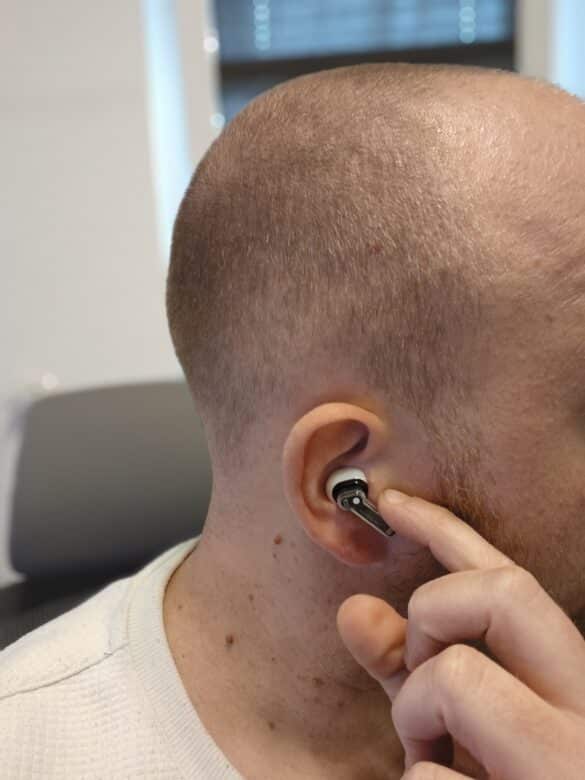
I also find the operation of the Nothing Ear very pleasant and precise, which is done by pressing together the touch surfaces provided for this purpose on the inside. The operation is clearly structured and doesn’t miss anything. A volume control can also be activated within the companion app.
Improved battery life
- around 5 hours (ANC) / 10 hours (without ANC) runtime
- 40 hours runtime with charging case
- Fast Charge; wireless charging
One of the biggest criticisms of the Ear (2) was the somewhat poor battery life, especially in conjunction with active noise cancellation. Nothing has improved noticeably here, but they still can’t keep up with the top models.
A maximum of 5.2 hours is possible with active ANC; without noise suppression, the runtime doubles to just under 10 hours. In combination with the charging case, we get a maximum runtime of around 40 hours.
All good values that will get you through a long day without any problems. But nothing earth-shattering either, when competitors such as the aforementioned Melomania M100 can last twice as long with 10 or 16 hours and the Sony WF-1000XM5 with active ANC also offers a full 8 hours of runtime.
At least there is a practical quick-charging function in the case, where 10 minutes is enough for up to 10 hours of playback without ANC. The case can be charged either via USB-C or even wirelessly using the Qi standard.
Major improvements in sound and ANC
- balanced, convincing sound
- detailed mids, strong and precise bass
However, the biggest leap forward for the Nothing Ear is in the sound, because it really has it all. Of course, the Ear (1) and Ear (2) already sounded quite good – considering the price – but couldn’t quite compete at the top.
The new Ear headphones didn’t make it to the top either, but the in-ear headphones are among the best. The broad and enormously detailed mids are particularly pleasing, creating a pleasantly neutral sound.
In direct comparison to the Melomania M100, however, the treble range lacks a little clarity and airiness, but these are also the flagship that currently has to be beaten in terms of sound.
Don’t get me wrong: The Nothing Ear sound excellent and, in my opinion, even better than the AirPods Pro 2 or Sennheiser Momentum True Wireless 3, for example. The Nothing Earbuds cope excellently with all genres.
In the demanding “Futura” by Hannah Parrott, for example, the Ear skillfully reproduces the strings in the background and creates a pleasantly spatial sound image. The bass reproduction in electro or hip-hop tracks such as “B.O.B.” by Outkast is also pleasing with a pleasant and at the same time precise pressure without overdriving – if you like, you can also add a five-stage bass boost in the companion app.
Dolby Atmos tracks such as “Running Out Of Time” by Wyatt Flores also score points with excellent spatiality in which all instruments can be perfectly located in the room. Ear only lacks a little finesse in the treble range.
But that’s criticism at a very high level. I am not currently aware of any in-ears in the price range up to 150 euros that deliver a more coherent and detailed sound.
Good ANC
- good active noise cancellation
- good transparency mode
The Nothing Ear also improve noticeably in terms of active noise suppression and already score points with very good passive attenuation, which is noticeably improved by adding ANC. The active noise cancellation can be set to three different levels (low, medium or high) in the app or adaptively adjusted to the ambient noise.
Muffled noises in particular are filtered out much more effectively than with the predecessors. Medium frequencies also disappear quite well, but voices in particular still come through, albeit attenuated.
The top models from Sony or Bose deliver noticeably better noise suppression, but here too the Nothing Ear can really be seen (or heard).
The same applies to the transparency mode, which has just been noticeably improved by a firmware update (to version 1.0.1.43). It offers a very natural sound that also allows for entertainment with in-ears. However, a slight background noise is perceptible and there is no voice amplification, which some other models offer and which I personally find very practical.
The microphone quality is also really good, but it’s not quite up there with the best.
Nothing Ear microphone test recording:
Microphone test recording Cambridge Audio Melomania M100:
Microphone test recording Marshall Motif II ANC:
All in all, the Nothing Ear are significantly improved in almost all respects compared to their predecessors. In terms of microphone quality, however, the suppression of ambient noise should be a little stronger.
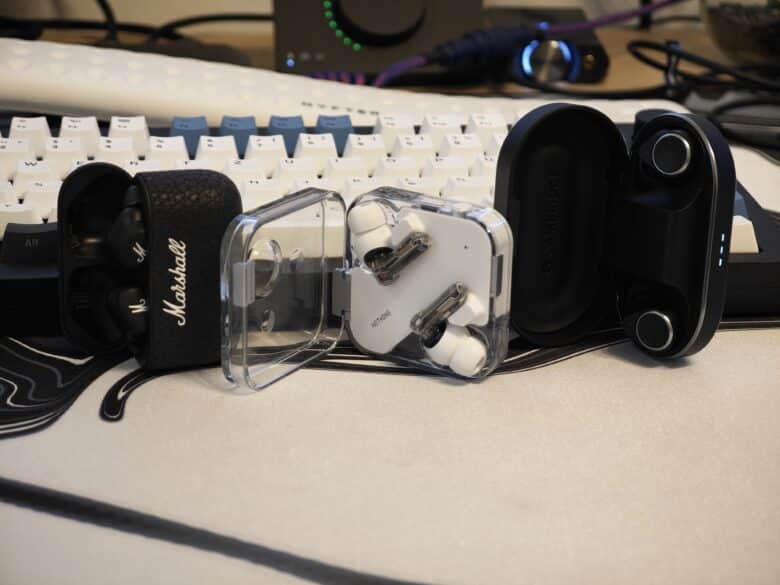
Nothing X app: Perhaps the best headphone companion app ever
- enormously comprehensive app
- Equalizer is second to none
In my opinion, Nothing deserves extensive praise for the Nothing X companion app, which is superior to all its competitors in terms of functionality. In addition to the obligatory options such as displaying the battery status or firmware updates, the equalizer in particular is second to none.
In addition to a simple EQ with four presets, you can also customize it and adjust bass, midrange or treble separately. In the advanced equalizer, on the other hand, you can go into great detail in 8 bands and adjust both the frequency and the Q factor for each band. The Q factor refers to the influence on the bandwidth around the selected frequency and therefore allows even greater individualization.
In addition to a pass test for the ear tips, there is also a sound test that allows the acoustics to be perfectly tuned to your own hearing ability. But that’s not all: you can also set the intensity of the personalized sound as a percentage, as well as three levels (Soft, Recommended or Stronger). No other manufacturer offers more customization options. Pretty impressive.
Nothing Ear Review: Conclusion
I’m going to say it: the Nothing Ear are the in-ear headphones to beat in the price range up to 150 euros. No competitor offers a more well-rounded overall package of convincing sound, modern features, outstanding wearing comfort and good battery life.
The improvements compared to the predecessor are particularly noticeable in the sound and ANC area, and while the Ear’s sound is among the best, the ANC is not yet in the top 5.
The whole thing is combined with the largely unchanged but unique and already iconic design and an increased battery life. However, Nothing deserves special praise for the companion app, which is unparalleled in terms of sound customization.
Nothing Ear
Workmanship
Comfort
Sound Quality
Microphone Quality
Features
Value For Money
92/100
A great sound, outstanding wearing comfort, good active noise suppression and significantly improved battery life make the Nothing Ear the best TWS in-ears currently available in the price segment up to 150 euros.



